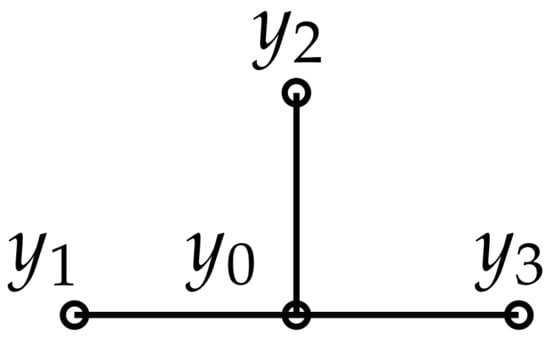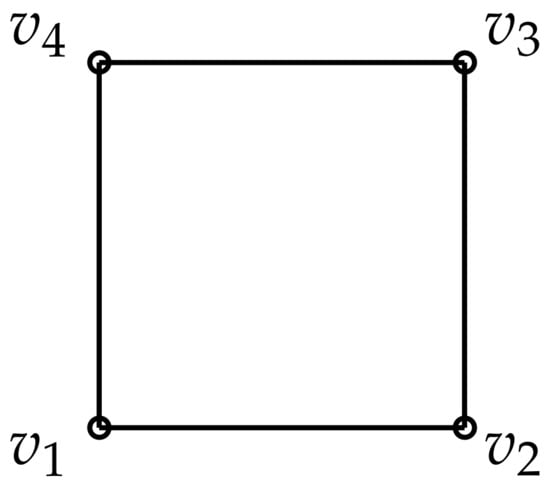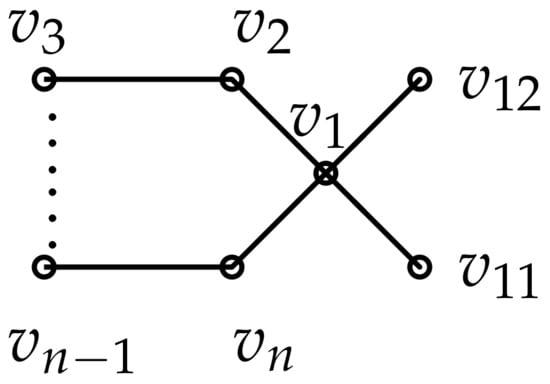Abstract
In this paper, completely regular endomorphisms of unicyclic graphs are explored. Let G be a unicyclic graph and let be the set of all completely regular endomorphisms of G. The necessary and sufficient conditions under which forms a monoid are given. It is shown that forms a submonoid of if and only if G is an odd cycle or for some odd and integer .
MSC:
05C25; 20M20
1. Introduction
The endomorphism monoids of graphs allow to establish a natural connection between graph theory and algebraic theory of semigroups. They have valuable applications (cf. [1]), many of which are related to automata theory (cf. [2,3]). In recent years, more and more scholors have paid attention to the endomorphism monoids of graphs and a large number of interesting results concerning combinatorial properties of graphs and algebraic properties of their endomorphism monoids have been obtained (see [4,5,6] and their references). In [7], endomorphisms and weak endomorphisms of a finite undirected path were characterized, the ranks of its endomorphism monoids and weak endomorphism monoids were determined. In [8], we studied regular endomorphisms of trees and determined the trees whose regular endomorphisms form a monoid. In [9], quasi-strong endomorphisms of a join of split graphs were explored, the conditions under which quasi-strong endomorphisms of the join of split graphs form a monoid were given. In [10], the endomorphism monoid of was explored. It was shown that is orthodox. In [11], Wilkeit determined endomorphism regular bipartite graphs. In [12], Hou and Luo constructed four classes of new endomorphism regular graphs by means of the join and the lexicographic product of two graphs with certain conditions. In particular, the join of connected bipartite graphs with regular endomorphism monoids were determined. The endomorphism regularity and endomorphism complete regularity of split graphs were studied separately by Li in [13,14]. Unicyclic graphs is a class of famous graphs; its endomorphism regularity was studied in [15].
An element a of a monoid S is said to be completely regular if there exists such that and . Let be the endomorphism monoid of a graph G and . Then f is called a completely regular endomorphism of G if it is a completely regular element of . The set of all completely regular endomorphisms of G is denoted by . In general, the composition of two completely regular elements of a monoid S is not completely regular. In [16], Hou and Gu posed the question: Under what conditions does the set form a monoid? However, it seems quite hard to obtain a complete solution to this question. Therefore a natural strategy for dealing with this question is to discover various kinds of conditions for various classes of graphs. In this paper, we shall give necessary and sufficient conditions under which completely regular endomorphisms of unicyclic graphs form a monoid. The main result of this paper will establish the relations between the combinatorial structure of unicyclic graphs and completely regular submonoids of its endomorphism monoids. The research of this scheme will enrich the contents of graph theory and algebraic theory of semigroups. We present a new method for characterizing completely regular endomorphisms of unicyclic graphs, which may be applied to characterizing completely regular endomorphisms of other classes of graphs.
2. Preliminary Concepts
The graph considered here is finite, undirected and simple. If and are adjacent in G, denote the edge connecting and by . For , set . Denote the cardinality of by and we call it the degree of v in G. A connected graph G is called a unicyclic graph if the number of its edges equal to the number of its vertices. Clearly, a unicyclic graph has a unique cycle.
Let G be a graph. A mapping f from to itself is called an endomorphism if implies . An endomorphism f is called an automorphism if and only if it is bijective. The set of all endomorphisms and automorphisms of G are written as and , respectively. Let . The endomorphic image of G under f is denoted by . Obviously, is a subgraph of G with and if and only if there exist and such that . An endomorphism f of G is called a retraction if and only if f is an idempotent in . A subgraph H of G is called a retract if and only if there exists a retraction f from G to H with . Denote the set of all idempotents of by .
We refer the reader to [2,17,18,19] for all the concepts not defined here. The following two lemmas quoted from the references will be used later.
Lemma 1
([20] Theorem 2.7). Let G be a graph and let . Then f is completely regular if and only if .
Lemma 2
([21] Corollary 2.3). Let G be a graph and H be a retract of G. If does not form a monoid, then does not form a monoid.
3. Unicyclic Graphs Whose Completely Regular Endomorphisms form a Monoid
In this section, completely regular endomorphisms of unicyclic graphs are explored. We give necessary and sufficient conditions for a unicyclic graph G under which forms a monoid. Firstly, we consider the unicyclic graph with a unique even cycle.
Lemma 3.
Let G be a unicyclic graph with a unique even cycle . If there exists such that , then does not form a monoid.
Proof.

Let G be a unicyclic graph with a unique even cycle . Clearly, G is bipartite. If there exists such that , then (see Figure 1) is a retract of G. By Lemma 2, we only need to show that the completely regular endomorphisms of do not form a monoid. Let
and

Figure 1.
Graph .
Then , . So . Now
It is routine to check that and . However, . By Lemma 1, . Hence does not form a monoid. □
Lemma 4.
Let with . Then does not form a monoid.
Proof.

Let G be an even cycle with . As , (see Figure 2) is a retract of G. By Lemma 2, we hope to show that all completely regular endomorphisms of do not form a monoid. Let
and

Figure 2.
Graph .
Then , . Thus . Now
It is not difficult to verify that and . However, . By Lemma 1, . Hence does not form a monoid. □
Lemma 5.

does not form a monoid. for Figure 3.

Figure 3.
Graph .
Proof.
Let
and
Then , . So . Now
It is not difficult to verify that and . However, . By Lemma 1, . Hence does not form a monoid. □
Lemma 6.
Let G be a unicyclic graph with a unique even cycle . Then does not form a monoid.
Proof.
This follows directly from Lemmas 3–5. □
Secondly, we start to look for conditions for a unicyclic graph G with a unique odd cycle, under which all completely regular endomorphisms of G form a monoid.
Lemma 7.
Let G be a unicyclic graph with a unique odd cycle . If there exist two vertices such that and , then does not form a monoid.
Proof.

Let G be a unicyclic graph with a unique odd cycle . If there exist two vertices such that and , then (see Figure 4) is a retract of G. By Lemma 2, we only need to show that does not form a monoid. Define a mapping f from to itself by

Figure 4.
Graph .
Let
Then and . Now
It is easy to see that and . However, . By Lemma 1, . Hence does not form a monoid. □
Lemma 8.
Let G be a unicyclic graph with a unique odd cycle . If there exists such that , then does not form a monoid.
Proof.

Let G be a unicyclic graphs with a unique odd cycle . If there exists such that , then (see Figure 5) is a retract of G. By Lemma 2, we only need to show that does not form a monoid. Let
and

Figure 5.
Graph .
Then . Hence . Now
It is not hard to see that and . However, . By Lemma 1, . Hence does not form a monoid. □
Lemma 9.
Let G be a unicyclic graph with a unique odd cycle . If there exists such that , then does not form a monoid.
Proof.

As there exists such that , (see Figure 6) is a retract of G. By Lemma 2, we hope to show that does not form a monoid. Let
and

Figure 6.
Graph .
Then . Hence . Now
It is not difficult to see that and . However, . By Lemma 1, . Hence does not form a monoid. □
Lastly, we investigate the completely regular endomorphisms of unicyclic graph (see Figure 7), where is an odd, is an integer.

Figure 7.
Graph .
Lemma 10.
Let and . Then or for some positive integer i with .
Proof.
As the endomorphism image of a connected graph is connected, is connected. Note that any endomorphism image of an odd cycle contains an odd cycle and is the unique odd cycle in G. Hence . This means that . Hence or for some positive integer i with . □
Lemma 11.
Let for some positive integer i and . Then for any .
Proof.
As , . Note that is the only vertex in G with degree 3. Hence . Recall that . This means . Note that . Then . Thus . As , . Since , . A similar argument will show that for any . □
Lemma 12.
Let . Then is completely regular if and only if
- (1)
- , or
- (2)
- for some positive integer i with . In this case, and for any .
Proof.
Necessity. Let . By Lemmas 10, or for some positive integer i with . As f is completely regular, by Lemma 1, . If , then for any by Lemma 11.
Sufficiency. As any endomorphism image of an odd cycle contains an odd cycle and is the unique odd cycle of G, . If , then , i.e. . Hence f is completely regular. If , then and for any . It is easy to check that . By Lemma 1, f is completely regular. □
Lemma 13.
Let . Then forms a monoid.
Proof.
Let f and g be two completely regular endomorphisms of G. We hope to show that . By Lemma 10, or for some positive integer i with , and or for some positive integer j with . There are two cases:
Case 1. or . Then . Thus . By Lemma 1, is completely regular.
Case 2. () and (). Without loss of generality, we suppose . By Lemma 12, have the following form:
where , and () is the image of . As , for .
where , and () is the image of , as , for .
Then
where , and for .
It is trivial to see that and for any . Since and , . By Lemma 12, .
Now we give the main result in this paper. □
Theorem 1.
Let G be a unicyclic graph. Then forms a monoid if and only if
- (1)
- G is an odd cycle, or
- (2)
- , where is an odd and is an integer.
Proof.
Necessity. This follows from Lemmas 6–9.
Sufficiency. If G is an odd cycle, then . Hence and so forms a monoid. If , then forms a monoid by Lemma 13. □
Author Contributions
Create and conceptualize ideas, H.H. and R.G.; writing—original draft preparation, H.H.; writing—review and editing, H.H. and R.G. All authors have read and agreed to the published version of the manuscript.
Funding
This research was partially supported by the National Natural Science Foundation of China (No. 11301151) and the Innovation Team Funding of Henan University of Science and Technology (NO. 2015XTD010).
Acknowledgments
The authors want to express their gratitude to the referees for their helpful suggestions and comments. The corresponding author Hailong Hou would like to thank Chris Godsil for discussions during his study in University of Waterloo from November 2016 to November 2017.
Conflicts of Interest
The authors declare no conflicts of interest.
References
- Kelarev, A.V.; Ryan, J.; Yearwood, J. Cayley graphs as classifiers for data mining: The influence of asymmetries. Discret. Math. 2009, 309, 5360–5369. [Google Scholar] [CrossRef]
- Kelarev, A.V. Graph Algebras and Automata; Marcel Dekker: New York, NY, USA, 2003. [Google Scholar]
- Kelarev, A.V.; Praeger, C.E. Labelled Cayley graphs and minimal automata. Aust. J. Combin. 2004, 30, 95–101. [Google Scholar]
- Böttcher, M.; Knauer, U. Endomorphism spectra of graphs. Discret. Math. 1992, 109, 45–57. [Google Scholar] [CrossRef]
- Gu, R.; Hou, H. End-regular and End-orthodox generalized lexicographic products of bipartite graphs. Open Math. 2016, 14, 229–236. [Google Scholar] [CrossRef]
- Kelarev, A.V.; Praeger, C.E. On transitive Cayley graphs of groups and semigroups. Eur. J. Combin. 2003, 24, 59–72. [Google Scholar] [CrossRef]
- Dimitrova, I.; Fernandes, V.H.; Koppitz, J.; Quinteiro, T.M. Ranks of Monoids of Endomorphisms of a Finite Undirected Path. Bull. Malays. Math. Sci. Soc. Available online: https://link.springer.com/article/10.1007/s40840-019-00762-4 (accessed on 19 April 2019).
- Gu, R.; Hou, H. Trees whose regular endomorphisms form a monoid. Discret. Math. 2020, 343, 111655. [Google Scholar] [CrossRef]
- Hou, H.; Gu, R.; Shang, Y. The join of split graphs whose quasi-strong endomorphisms form a monoid. Bull. Aust. Math. Soc. 2015, 91, 1–10. [Google Scholar] [CrossRef]
- Hou, H.; Luo, Y.; Cheng, Z. The Endomorphism monoid of . Eur. J. Combin. 2008, 29, 1173–1185. [Google Scholar] [CrossRef]
- Wilkeit, E. Graphs with regular endomorphism monoid. Arch. Math. 1996, 66, 344–352. [Google Scholar] [CrossRef]
- Hou, H.; Luo, Y. Graphs whose endomorphism monoids are regular. Discret. Math. 2008, 308, 3888–3896. [Google Scholar] [CrossRef]
- Li, W.; Chen, J. Endomorphism-regularity of split graphs. Eur. J. Combin. 2001, 22, 207–216. [Google Scholar] [CrossRef]
- Li, W. Split graphs with completely regular endomorphism monoids. J. Math. Res. Expo. 2006, 26, 253–263. [Google Scholar]
- Ma, X.; Wong, D.; Zhou, J. Unicyclic graphs with regular endomorphism monoids. Discret. Math. Algorithms Appl. 2016, 8, 1650020. [Google Scholar] [CrossRef]
- Hou, H.; Gu, R. Split graphs whose completely regular endomorphisms form a monoid. ARS Combin. 2016, 127, 79–88. [Google Scholar] [CrossRef]
- Kelarev, A.V. Ring Constructions and Applications; World Scientific: River Edge, NJ, USA, 2002. [Google Scholar]
- Knauer, U. Algebraic Graph Theory: Morphisms, Monoids and Matrices; De Gruyter: Boston, MA, USA, 2011. [Google Scholar]
- Rashmanlou, H.; Pal, M.; Raut, S.; Mofidnakhaei, F.; Sarkar, B. Novel concepts in intuitionistic fuzzy graphs with application. J. Intell. Fuzzy Syst. 2019, 37, 3743–3749. [Google Scholar] [CrossRef]
- Li, W. On completely regular endomorphisms of a graph. J. Math. (PRC) 1997, 17, 1–7. [Google Scholar]
- Gu, R.; Hou, H. Graphs whose completely regular endomorphisms form a monoid. Ital. J. Pure Appl. Math. 2020. to appear. [Google Scholar]
© 2020 by the authors. Licensee MDPI, Basel, Switzerland. This article is an open access article distributed under the terms and conditions of the Creative Commons Attribution (CC BY) license (http://creativecommons.org/licenses/by/4.0/).